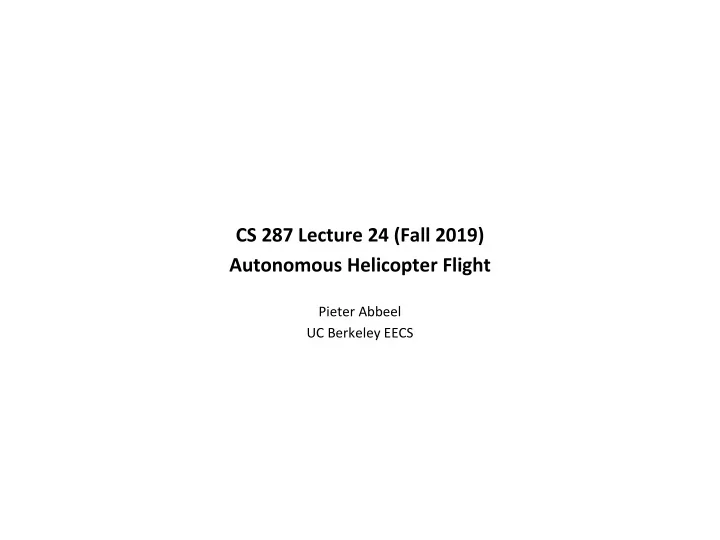

CS 287 Lecture 24 (Fall 2019) Autonomous Helicopter Flight Pieter Abbeel UC Berkeley EECS
Challenges in Helicopter Control n Unstable n Nonlinear n Complicated dynamics n Air flow n Coupling n Blade dynamics n Noisy estimates of position, orientation, velocity, angular rate (and perhaps blade and engine speed)
Success Stories: Hover and Forward Flight n Just a few examples: Bagnell & Schneider, 2001; n LaCivita, Papageorgiou, Messner & Kanade, 2002; n Ng, Kim, Jordan & Sastry 2004a (2001); Ng et al., 2004b; n Roberts, Corke & Buskey, 2003; n Saripalli, Montgomery & Sukhatme, 2003; n Shim, Chung, Kim & Sastry, 2003; n Doherty et al., 2004; n Gavrilets, Martinos, Mettler and Feron, 2002. n n Varying control techniques: inner/outer loop PID with hand or automatic tuning, H1, LQR, …
[Ng, Coates, Tse, et al, 2004]
Alan Szabo – Sunday at the Lake
One of our first attempts at autonomous flips [using similar methods to what worked for ihover] Target trajectory: meticulously hand-engineered Model: from (commonly used) frequency sweeps data
Stationary vs. Aggressive Flight Hover / stationary flight regimes: n n Restrict attention to specific flight regime n Extensive data collection = collect control inputs, position, orientation, velocity, angular rate n Build model + model-based controller à Successful autonomous flight. Aggressive flight maneuvers --- additional challenges: n n Task description : What is the target trajectory? n Dynamics model : How to obtain accurate model?
Aggressive, Non-Stationary Regimes n Gavrilets, Martinos, Mettler and Feron, 2002 n 3 maneuvers: split-S, snap axial roll, stall-turn n Key: Expert engineering of controllers after human pilot demonstrations
Sunday in Open Loop
Aggressive, Non-Stationary Regimes n Our work: n Key: Automatic engineering of controllers after human pilot demonstrations through machine learning n Wide range of aggressive maneuvers n Maneuvers in rapid succession
Learning Dynamic Maneuvers n Learning a target trajectory n Learning a dynamics model n Autonomous flight results
Target Trajectory n Difficult to specify by hand: n Required format: position + orientation over time n Needs to satisfy helicopter dynamics n Our solution: n Collect demonstrations of desired maneuvers n Challenge: extract a clean target trajectory from many suboptimal/noisy demonstrations Abbeel, Coates, Ng, IJRR 2010
Expert Demonstrations
Learning a Trajectory Hidden Demo 1 Demo 2 HMM-like generative model • Dynamics model used as HMM transition model – Demos are observations of hidden trajectory – Problem: how do we align observations to hidden trajectory? • Abbeel, Coates, Ng, IJRR 2010
Learning a Trajectory Hidden Demo 1 Demo 2 n Dynamic Time Warping (Needleman&Wunsch 1970, Sakoe&Chiba, 1978) n Extended Kalman filter / smoother Abbeel, Coates, Ng, IJRR 2010
Results: Time-Aligned Demonstrations § White helicopter is inferred “intended” trajectory.
Results: Loops Even without prior knowledge, the inferred trajectory is much closer to an ideal loop. Abbeel, Coates, Ng, IJRR 2010
Learning Dynamic Maneuvers n Learning a target trajectory n Learning a dynamics model n Autonomous flight results
Standard Modeling Approach 3G error! Abbeel, Coates, Ng, IJRR 2010
Key Observation Errors observed in the “baseline” model are clearly consistent after aligning demonstrations. Abbeel, Coates, Ng, IJRR 2010
Key Observation n If we fly the same trajectory repeatedly, errors are consistent over time once we align the data. n There are many unmodeled variables that we can’t expect our model to capture accurately. n Air (!), actuator delays, etc. n If we fly the same trajectory repeatedly, the hidden variables tend to be the same each time. ~ muscle memory for human pilots Abbeel, Coates, Ng, IJRR 2010
Trajectory-Specific Local Models n Learn locally-weighted model from aligned demonstrations n Since data is aligned in time, we can weight by time to exploit repeatability of unmodeled variables. n For model at time t: n Obtain a model for each time t into the maneuver by running weighted regression for each time t Abbeel, Coates, Ng, IJRR 2010
Learning Dynamic Maneuvers n Learning a target trajectory n Learning a dynamics model n Autonomous flight results Abbeel, Coates, Ng, IJRR 2010
Experimental Setup Extended Kalman Filter Offboard Cameras 1280x960@20Hz RHDDP controller “Position” 3-axis magnetometer, accelerometer, gyroscope (“Orientation”) Controls @ 20Hz Microstrain 3DM-GX1 @333Hz RPM sensor @20-30Hz Sonar Abbeel, Coates, Quigley, Ng, NIPS 2007
Experimental Procedure 1. Collect sweeps to build a baseline dynamics model 2. Our expert pilot demonstrates the airshow several times. 3. Learn a target trajectory. 4. Learn a dynamics model. 5. Find the optimal control policy for learned target and dynamics model. 6. Autonomously fly the airshow 7. Learn an improved dynamics model. Go back to step 4. à Learn to fly new maneuvers in < 1hour. Abbeel, Coates, Ng, IJRR 2010
Results: Autonomous Airshow
Results: Flight Accuracy
Autonomous Autorotation Flights Abbeel, Coates, Hunter, Ng, ISER 2008
Chaos [“flip/roll” parameterized by yaw rate]
Behind the scenes
Thank you!
Recommend
More recommend